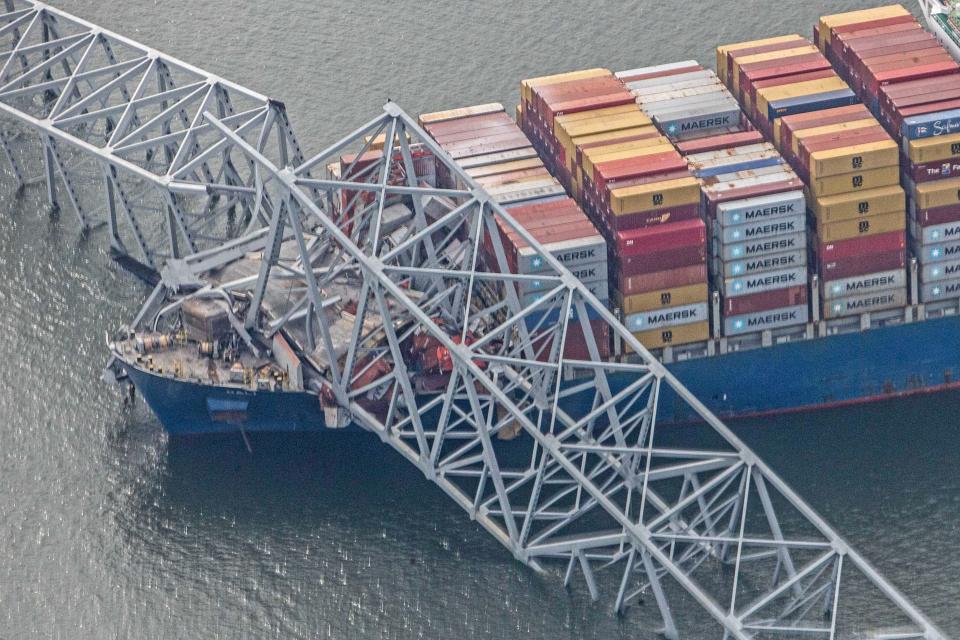Five tough questions in the wake of the Baltimore Key Bridge collapse
As the full scope of the dramatic and shocking collapse of Baltimore's crucial Francis Scott Key Bridge comes into focus, the region and the nation are just beginning to grapple with what the future, both near and long-term, might hold, but there are tough questions still unanswered.
The bridge was a critical link in the transportation system serving a metro area of more than 2.8 million people and a vital artery for East Coast shipping. Its collapse not only means the loss of a major roadway but also at least temporarily a large, thriving port until the wreckage of the bridge and the ship can be cleared and, perhaps, a new bridge can be constructed.
Here are some of the unknowns and some questions without easy answers.
Why did a cargo ship ram the Francis Scott Key Bridge?
The cause of the collapse was evident in gut-wrenching video that captured the moments Tuesday when the Dali, a hulking, Sri Lanka-bound cargo ship, hit one of the bridge's A-shaped support piers, causing the steel structure to fail and fall into the Patapsco River.
Officials say the 984-foot ship suffered a power outage and sounded a mayday, allowing them to stop vehicle traffic before the collision. But they have not yet elaborated on why the ship lost power or other factors that may have played a role. The National Transportation Safety Board recovered the vessel's black box recorder and the investigation is ongoing.
What happened, in depth: A giant ship. A power blackout. A scramble to stop traffic: How Baltimore bridge collapsed
How long will it take to remove the ship and the debris in the water?
Benjamin Schafer, a professor of civil and systems engineering at Johns Hopkins University, said Wednesday that it would be difficult to gauge how long it might take to remove debris from the Dali and the bridge.
But in a meeting with journalists, he indicated it would be wise to think in terms of months, rather than weeks.
“I’d be shocked if it’s weeks but I don’t think it’ll take even a year,” said Schafer, a structural engineer.
The latest news: Baltimore bridge recovery effort presses on; 22-member crew still aboard ship
How long will it take to rebuild the bridge in Baltimore?
A complete rebuild could take a decade or more, Schafer said. He noted that building the original bridge took five years and rebuilding the Skyway Bridge in Tampa after it was hit by a freighter in 1980 took seven.
“To actually recreate that whole transportation network," he said. "Projects that large take “rarely less than 10 years."
Visualizing the collision and collapse: After ship hits Baltimore bridge, mapping how the collapse unfolded
How much will all of this cost?
Addressing the crisis from the White House, President Joe Biden on Tuesday pledged federal support for the rebuilding process.
“It's my intention that federal government will pay for the entire cost of reconstructing that bridge. And I expect the Congress to support my effort,” Biden said. "It's going to take some time. The people of Baltimore can count on us, though, to stick with them at every step of the way until the port is reopened and the bridge is rebuilt."
Who will pay for it? With death toll unknown and bridge collapsed, Biden pledges federal support for Baltimore
That tab could be exceptionally high, Schafer said. Removing the Dali and the bridge debris and rebuilding the bridge and surrounding infrastructure would be an enormous undertaking at today's rates.
"The price tags never seem to be out of the hundred of millions these days," he said.

How can disasters like the collapse of the Baltimore bridge be prevented?
Susu Xu, an assistant professor at Johns Hopkins' Department of Civil and Systems Engineering, said there are some steps that can be taken to try and avert a bridge collapse and potentially catastrophic loss of life.
Aging infrastructure: Baltimore bridge collapse reignites calls for fixes to America's aging bridges
Sensors could be installed on piers or bridge decks to detect when a ship is getting too close and trigger warning lights to stop traffic from entering the bridge and alert emergency responders and other agencies, Xu said.
Building collapse-proof bridges is more challenging, Schafer said. It could be done, but it would be costly. So-called dolphin structures – barriers placed near bridges to divert ships – can be helpful, he said, but they might not work, given the sheer volume of cargo vessels.
"These things are a balance and we as a society, we have to try to make these choices the best we can to have the economic engines like the port, to have a transportation network," Schafer said. "What it feels like right now is that we didn't get the balance right, and there needed to be more consideration for this possible event."
This article originally appeared on USA TODAY: Five big questions in the wake of the Baltimore bridge collapse

